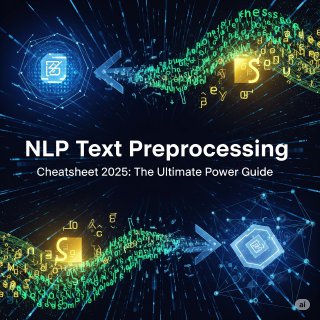August 23, 2025 by Vanita.ai
Natural Language Processing (NLP) powers applications like chatbots, translation systems, sentiment analysis, and large language models (LLMs). But before machines can understand text, it must be cleaned, structured and normalized. This is where text preprocessing comes in.

Think of preprocessing as preparing raw ingredients before cooking without it, even the most powerful models like BERT, GPT or Gemini struggle to interpret messy data.
This cheatsheet explains every major preprocessing step with definitions, examples and modern best practices.
Table of Contents
1. Lowercasing
Converting all characters in text to lowercase for uniformity. Prevents treating “Apple” and “apple” as different words.
text = "Natural Language Processing is AMAZING!"
print(text.lower()) # "natural language processing is amazing!"
2. Tokenization
Splitting text into smaller units (tokens) like words, sentences, or subwords. Essential for model input.
from nltk.tokenize import word_tokenize, sent_tokenize
print(word_tokenize("Natural Language Processing is amazing in 2025."))
print(sent_tokenize("Transformers are powerful. They changed Natural Language Processing."))
For transformers:
from transformers import AutoTokenizer
tok = AutoTokenizer.from_pretrained("bert-base-uncased")
print(tok("Natural Language Processing revolutionizes AI in 2025"))
3. Stopword Removal
Eliminating common words (e.g., is, the, an) that usually don’t add semantic meaning in traditional models.
from nltk.corpus import stopwords
stop_words = set(stopwords.words("english"))
tokens = ["this", "is", "an", "example"]
print([w for w in tokens if w not in stop_words]) # ['example']
4. Stemming & Lemmatization
- Stemming: Cutting words to their root form using simple rules. Often crude.
- Lemmatization: Mapping words to their proper dictionary base form using grammar and vocabulary.
from nltk.stem import PorterStemmer
ps = PorterStemmer()
print(ps.stem("running")) # run
from nltk.stem import WordNetLemmatizer
lemmatizer = WordNetLemmatizer()
print(lemmatizer.lemmatize("better", pos="a")) # good
Best practice (2025): Prefer lemmatization for accuracy.
5. Removing Punctuation, Numbers and Extra Spaces
Cleaning text by stripping unnecessary symbols, digits, and whitespace.
import string, re
text = "Hello!!! NLP in 2025 costs $100."
text = re.sub(r"\d+", "", text)
text = "".join([c for c in text if c not in string.punctuation])
text = " ".join(text.split())
print(text)
6. Handling Contractions
Expanding shortened word forms to their full forms. Example: “don’t” → “do not”.
import contractions
print(contractions.fix("I can't believe it's already 2025!"))
# "I cannot believe it is already 2025!"
7. Normalizing Accents / Unicode
Standardizing text by removing diacritics and converting characters to a uniform format.
import unicodedata
print(unicodedata.normalize("NFKD", "Café").encode("ascii","ignore").decode("utf-8"))
# "Cafe"
8. Emojis & Emoticons
Emojis carry semantic and emotional meaning. Instead of removing, convert them to text form.
import emoji
print(emoji.demojize("I love Natural Language Processing😊"))
# "I love Natural Language Processing :smiling_face_with_smiling_eyes:"
9. URLs, Emails, Mentions, Hashtags
Removing or standardizing noisy elements like links, emails, and social media symbols.
import re
text = "Contact me at abc@mail.com or visit https://example.com #AI @user"
text = re.sub(r"http\S+", "", text) # URLs
text = re.sub(r"\S+@\S+", "", text) # Emails
text = re.sub(r"@\w+", "", text) # Mentions
text = re.sub(r"#\w+", "", text) # Hashtags
print(text)
10. Spelling Correction
Correcting typos and misspelled words to improve model understanding.
from textblob import TextBlob
print(str(TextBlob("I liek naturall languaage processng").correct()))
# "I like natural language processing"
11. Handling Rare & Frequent Words
Filtering out overly rare or common words that add little value.
from collections import Counter
words = ["nlp", "nlp", "python", "data", "transformers", "transformers", "transformers"]
print(Counter(words).most_common())
12. Handling OOV (Out-of-Vocabulary) Words
Managing words not in the vocabulary by replacing them with <UNK> or splitting into subwords.
vocab = {"nlp":1, "python":2}
tokens = ["nlp", "rocks"]
print([w if w in vocab else "<UNK>" for w in tokens])
# ['nlp', '<UNK>']
13. Data Augmentation
Expanding training data with synthetic variations (synonyms, back translation, paraphrasing).
import nlpaug.augmenter.word as naw
aug = naw.SynonymAug(aug_p=0.3)
print(aug.augment("Natural Language Processing is amazing in 2025"))
14. Advanced Preprocessing for Transformers
Preprocessing tailored for transformer models like BERT/GPT, which use subword tokenization.
- Use subword tokenization (BPE, WordPiece, SentencePiece).
- Avoid over-cleaning (don’t remove stopwords/punctuation aggressively).
- Add special tokens like
[CLS],[SEP],<pad>,<unk>.
15. End-to-End Preprocessing Pipeline
A combined pipeline for real-world preprocessing.
def preprocess(text):
text = text.lower()
text = contractions.fix(text)
text = re.sub(r"http\S+|@\w+|#\w+", "", text)
text = "".join([c for c in text if c not in string.punctuation])
tokens = word_tokenize(text)
tokens = [w for w in tokens if w not in stop_words]
tokens = [lemmatizer.lemmatize(w) for w in tokens]
return " ".join(tokens)
print(preprocess("I can't wait for Natural Language Processing in 2025!!! #AI @OpenAI"))
16. Text Vectorization
Vectorization is the process of converting preprocessed text into numerical features so that machine learning (ML) and deep learning models can process it. Since models cannot directly understand raw text, vectorization bridges the gap between human language and numerical computation
There are four major categories of vectorization techniques:
16.1 Bag of Words (BoW)
Definition: Represents text as a “bag” of unique words with their frequencies (order of words is ignored).
Pros: Simple, interpretable, effective for small datasets.
Cons: Loses word order, leads to very sparse vectors for large vocabularies.
from sklearn.feature_extraction.text import CountVectorizer
corpus = ["NLP is powerful", "NLP is amazing"]
vectorizer = CountVectorizer()
X = vectorizer.fit_transform(corpus)
print(vectorizer.get_feature_names_out())
print(X.toarray())
Output:
['amazing' 'is' 'nlp' 'powerful']
[[0 1 1 1]
[1 1 1 0]]
16.2 TF-IDF (Term Frequency – Inverse Document Frequency)
Definition: Assigns weight to words based on their frequency in a document relative to how often they appear across all documents. Words that appear in many documents get lower importance.
Pros: Reduces impact of common words, better than BoW for information retrieval.
Cons: Still ignores context and word order.
from sklearn.feature_extraction.text import TfidfVectorizer
corpus = ["NLP is powerful", "NLP is amazing"]
vectorizer = TfidfVectorizer()
X = vectorizer.fit_transform(corpus)
print(vectorizer.get_feature_names_out())
print(X.toarray())
16.3 Word Embeddings (Word2Vec, GloVe, FastText)
Dense vector representations where semantic meaning is captured. Words with similar meanings are close in vector space.
- Word2Vec: Learns embeddings using Skip-Gram or CBOW models.
- GloVe: Learns embeddings from co-occurrence statistics.
- FastText: Handles subword information, better for rare words.
Pros: Captures semantic meaning and relationships (king – man + woman ≈ queen).
Cons: Static embeddings (word meaning doesn’t change with context).
import gensim.downloader as api
# Load pre-trained Word2Vec
word_vectors = api.load("word2vec-google-news-300")
print(word_vectors.most_similar("nlp", topn=3))
print(word_vectors["python"].shape) # 300-dimensional vector
16.4 Transformer Embeddings (BERT, RoBERTa, GPT)
Contextual embeddings generated by transformer-based models. Unlike Word2Vec/GloVe, the same word can have different meanings depending on its context.
Pros: Context-aware, state-of-the-art for Natural Language Processing tasks.
Cons: Computationally expensive, requires GPU for large models.
from transformers import AutoTokenizer, AutoModel
import torch
tokenizer = AutoTokenizer.from_pretrained("bert-base-uncased")
model = AutoModel.from_pretrained("bert-base-uncased")
sentence = "NLP makes AI powerful."
inputs = tokenizer(sentence, return_tensors="pt")
outputs = model(**inputs)
# CLS token embedding (sentence-level representation)
cls_embedding = outputs.last_hidden_state[:,0,:]
print(cls_embedding.shape) # torch.Size([1, 768])Conclusion
Text preprocessing is not just a technical step, it is the foundation of every Natural Language Processing workflow. From cleaning noisy social media text to preparing structured corpora for training transformers, the right preprocessing strategy can dramatically impact model accuracy, efficiency, and robustness.
In this Natural Language Processing Text Preprocessing Cheatsheet 2025, we walked through:
- Fundamental steps such as lowercasing, tokenization, stopword removal, and lemmatization.
- Advanced techniques including handling contractions, negations, rare words and emojis.
- Transformer-focused practices like subword tokenization and special tokens.
- Practical pipelines that combine multiple steps for real-world projects.
As Natural Language Processing continues to evolve with LLMs and domain-specific AI systems, preprocessing will remain the key to bridging raw human language with machine understanding. By mastering these techniques, you equip yourself to build smarter chatbots, accurate sentiment analyzers and reliable enterprise Natural Language Processing solutions.
Keep this cheatsheet as your go-to reference and remember: in Natural Language Processing, better preprocessing often means better results.
Related Reads
- Plotly Cheatsheet 2025: Powerful Techniques from Beginner to Advanced
- Matplotlib Cheatsheet 2025: From Beginner to Advanced
- Scikit-learn Cheatsheet 2025: From Beginner to Advanced
- NumPy Cheatsheet 2025: From Basics to Advanced in One Guide
- Pandas Cheatsheet: The Ultimate Guide for Data Analysis in Python
External Resources
NLTK Official Documentation – Comprehensive library for text preprocessing, tokenization, stopwords, and lemmatization.
spaCy Documentation – Modern Natural Language Processing toolkit for industrial-grade preprocessing pipelines.
Hugging Face Transformers – Guide to tokenization, preprocessing, and transformer-based models.
Stanford NLP Group – Classic Natural Language Processing tools like CoreNLP with tokenizers, lemmatizers, and parsers.
TextBlob – Beginner-friendly library for text preprocessing, sentiment analysis, and spelling correction.
NLPAug Library – A Python library for data augmentation in Natural Language Processing .
FastText (Facebook Research) – Pretrained word vectors and preprocessing insights for embeddings.
Scikit-learn Feature Extraction – Tools for preprocessing text into machine-learning-ready features like BoW and TF-IDF.
Google Cloud NLP Documentation – API-level tools for text analysis, tokenization and preprocessing in production.

5 thoughts on “NLP Text Preprocessing Cheatsheet 2025: The Ultimate Powerful Guide”